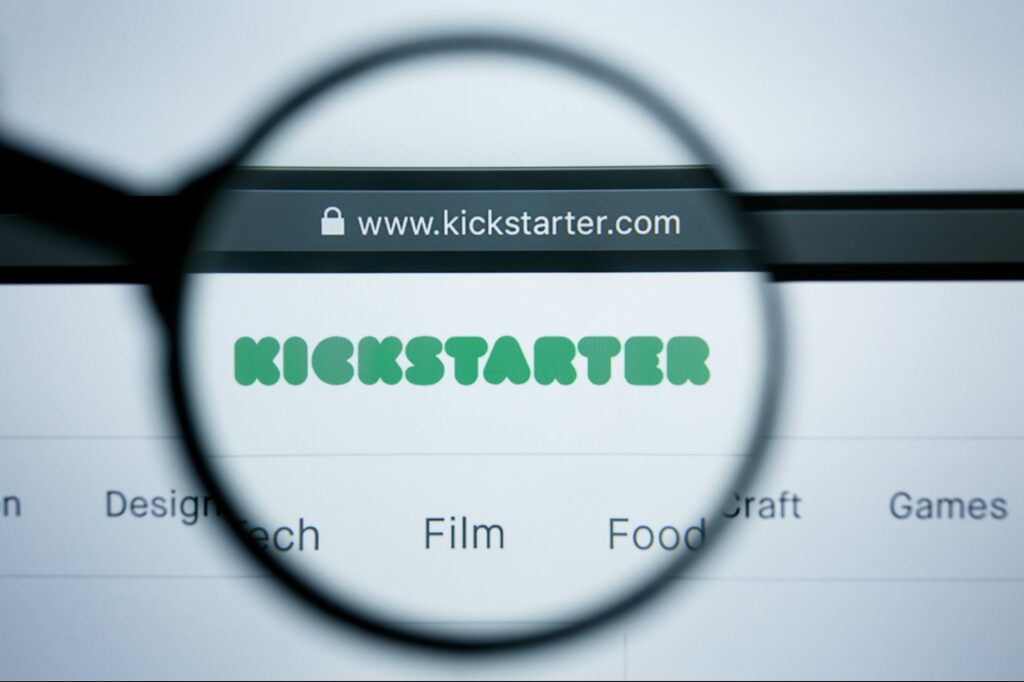Kickstarter, the popular crowdfunding platform, is making a move to incorporate blockchain technology in its mission to make crowdfunding easier. In a recent blog post, Kickstarter announced its support for the development of an open-source protocol that will create a decentralized version of its functionality. This new protocol will not only be used by Kickstarter but will also be available to competitors and independent contributors from around the world. By embracing blockchain technology, Kickstarter hopes to open up new opportunities for creative projects to come to life. While users may not see a visible shift in the platform, they will witness the benefits of the improvements. This development is set to begin in the first quarter of 2022, with a full transition expected later in the year.

Introduction
Welcome to this article about Kickstarter’s move to blockchain technology and its potential impact on crowdfunding. In this comprehensive piece, we will explore the background of Kickstarter and crowdfunding, the specific move to blockchain, the partnership with Celo, the impact on Kickstarter users, the timeline and transition, the similarities between blockchain and crowdfunding, the potential of decentralized networks, and the importance of supporting creative projects. By the end of this article, you will have a thorough understanding of Kickstarter’s move to blockchain and its implications for the crowdfunding industry.
Background of Kickstarter and Crowdfunding
Kickstarter is a widely known crowdfunding platform that has been in operation since 2009. It allows creators to raise funds for their projects by relying on the support of backers who contribute money in exchange for rewards. Over the years, Kickstarter has facilitated the funding of various creative projects, including films, music albums, video games, art installations, and more.
Crowdfunding, in general, has become a popular way for creators to bring their ideas to life. It provides an alternative to traditional financing methods by allowing individuals to directly support projects they believe in. By leveraging the power of the crowd, crowdfunding has democratized the funding landscape and enabled creators to access capital without the need for traditional investors or institutions.

Kickstarter’s Move to Blockchain
In a recent blog post, Kickstarter announced its intention to incorporate blockchain technology into its crowdfunding platform. By doing so, Kickstarter aims to support the development of an open-source protocol that will create a decentralized version of its functionality. This move signifies Kickstarter’s commitment to embracing technological advancements and exploring new ways to enhance the crowdfunding experience for both creators and backers.
Supporting the development of an open-source protocol
Kickstarter’s move to blockchain involves supporting the development of an open-source protocol that will form the foundation of the decentralized platform. By contributing to the development of this protocol, Kickstarter aims to foster innovation and collaboration within the crowdfunding community. The open-source nature of the protocol will allow independent contributors, collaborators, and even competitors to build upon, connect to, or use the new infrastructure.
Creating a decentralized version of its functionality
The incorporation of blockchain technology will enable Kickstarter to create a decentralized version of its functioning. This means that the platform will no longer rely on a centralized authority to facilitate crowdfunding campaigns. Instead, the power will be distributed among the participants, making the system more resilient, transparent, and secure. This shift aligns with the core principles of blockchain technology, which advocates for decentralization and peer-to-peer interactions.
Availability for collaborators, independent contributors, and competitors
One of the key highlights of Kickstarter’s move to blockchain is its commitment to making the new infrastructure available to collaborators, independent contributors, and even competitors. This openness reflects Kickstarter’s belief in collective innovation and the power of the crowd. By allowing others to build upon the protocol, Kickstarter aims to create a vibrant ecosystem that fosters collaboration and supports the growth of the crowdfunding industry as a whole.
Release of a white paper outlining the technology and plans
To provide further insights into its move to blockchain, Kickstarter plans to release a white paper that outlines the underlying technology and its future plans. This white paper will serve as a roadmap, guiding the development and implementation of the blockchain-based crowdfunding platform. By sharing their vision and technological approach, Kickstarter aims to involve the community and gather feedback from stakeholders who are interested in the future of the crowdfunding industry.
Partnership with Celo
Kickstarter has formed a partnership with Celo, an open-source, carbon-negative blockchain platform, to build the new protocol. This collaboration combines Kickstarter’s expertise in crowdfunding with Celo’s advanced blockchain technology, creating a powerful synergy that aims to revolutionize the crowdfunding landscape.
Kickstarter partnering with open-source, carbon-negative blockchain platform Celo
Celo is a blockchain platform designed to enable fast, secure, and accessible financial transactions. It has gained recognition for its commitment to sustainability, as it operates with a carbon-negative footprint. By partnering with Celo, Kickstarter demonstrates its dedication to environmental responsibility and aligns itself with a blockchain platform that shares its values and vision.
Collaboration for building the new protocol
The partnership between Kickstarter and Celo involves collaborative efforts to build the new protocol. Drawing on their respective expertise, the two organizations will work together to design and develop a blockchain-based infrastructure that meets the specific needs of the crowdfunding industry. This collaboration enables Kickstarter to leverage the technical capabilities of Celo and create a robust and reliable platform for creators and backers.

Impact on Kickstarter Users
As Kickstarter transitions to a blockchain-based crowdfunding platform, users can expect certain changes and improvements. However, Kickstarter assures its users that they will not experience a significant visible shift in the way they use the platform.
Users will not see a visible shift
According to Bloomberg, Kickstarter users will not see a visible shift as a result of the move to blockchain. This means that the user interface and overall user experience are not expected to undergo drastic changes. Kickstarter aims to maintain familiarity and continuity for its users while leveraging the benefits of blockchain technology behind the scenes.
Improvements that users will benefit from
Although the shift to blockchain may not be immediately apparent to users, it will bring several improvements to the Kickstarter platform. Blockchain technology provides enhanced security, transparency, and immutability, which can benefit both creators and backers. The decentralized nature of the platform ensures that transactions are recorded on a tamper-proof ledger, protecting the integrity of the crowdfunding process. Additionally, the use of smart contracts can automate certain aspects of the crowdfunding process, reducing the administrative burden for creators.
Timeline and Transition
Kickstarter’s transition to a blockchain-based crowdfunding platform is expected to take place over a specific timeline.
Development starting in the first quarter of 2022
According to the announcements made by Kickstarter, development work on the new blockchain-based infrastructure will commence in the first quarter of 2022. This phase will involve extensive research, design, and implementation to ensure the successful integration of blockchain technology into the existing platform.
Expected transition later in the year
Following the development phase, Kickstarter expects to transition to the new blockchain-based platform later in the year. This transition will involve migrating existing crowdfunding campaigns and data to the decentralized protocol, ensuring a smooth and seamless user experience throughout the process. Kickstarter will provide updates and guidance to its users to facilitate this transition and ensure minimal disruption.

Similarities between Blockchain and Crowdfunding
The integration of blockchain technology into Kickstarter’s crowdfunding platform highlights the similarities between the two domains. These similarities played a role in the decision to explore blockchain as a means to enhance the crowdfunding experience.
Exploring the connection between blockchain technology and crowdfunding
Blockchain technology and crowdfunding share certain fundamental principles that make them well-suited for integration. Both concepts emphasize decentralization, transparency, and community participation. Blockchain technology provides a secure and transparent infrastructure for recording transactions and can enhance the trust between creators and backers in the crowdfunding process.
Examples of blockchain technology used for funding projects
The integration of blockchain technology in the crowdfunding industry is not entirely new. Distributed Autonomous Organizations (DAOs) have already leveraged blockchain technology to fund various projects. One notable example is ConstitutionDAO, which raised more than $40 million through blockchain-based crowdfunding to attempt to purchase the Constitution. These examples illustrate the potential of blockchain technology to revolutionize the way projects are funded and supported.
The Potential of Decentralized Networks
Kickstarter’s move to blockchain reflects a broader belief in the potential of decentralized networks to reshape the internet and transform various industries, including crowdfunding.
Belief in the reconstruction of the internet by decentralized networks
Kickstarter’s decision to embrace blockchain technology stems from a belief in the reconstruction of the internet through decentralized networks. By distributing power and decision-making among participants, decentralized networks empower individuals and communities to actively engage in the design, operation, governance, and even ownership of technology. This decentralized approach fosters innovation, collaboration, and inclusivity, providing a more democratic and equitable foundation for the crowdfunding industry.
Participation in design, operation, governance, and ownership of technology
Blockchain technology enables participants to actively participate in the design, operation, governance, and ownership of the technology they use. This participatory model aligns with the values of Kickstarter, which aims to empower both creators and backers to have a voice in the crowdfunding process. By leveraging blockchain’s decentralized nature, Kickstarter seeks to create an ecosystem that values the contributions of all participants and promotes a more inclusive and equitable crowdfunding experience.
Importance of Supporting Creative Projects
Kickstarter’s move to blockchain technology ultimately aims to support the development of creative projects and facilitate the realization of innovative ideas.
Contributing to the development of infrastructure and tools
By embracing blockchain technology, Kickstarter contributes to the development of the infrastructure and tools needed to enhance the crowdfunding ecosystem. The integration of blockchain provides creators with a secure and efficient platform to showcase their projects, while also giving backers a transparent and reliable means to support the projects they believe in.
Serving the mission of bringing creative projects to life
At its core, Kickstarter’s mission is to bring creative projects to life by connecting creators with backers. The move to blockchain technology aligns with this mission, as it enables Kickstarter to leverage the power of a decentralized network to foster collaboration, transparency, and trust. By enhancing the crowdfunding experience, Kickstarter continues to support the creative community and democratize the process of bringing ideas to fruition.
Conclusion
Kickstarter’s move to blockchain technology marks an exciting milestone for the crowdfunding industry. By embracing decentralization and leveraging the power of blockchain, Kickstarter aims to enhance the crowdfunding experience for both creators and backers. The partnership with Celo and the commitment to an open-source protocol demonstrate Kickstarter’s dedication to collaboration, innovation, and inclusivity. As the development progresses and the transition to the new platform takes place, users can expect improvements in security, transparency, and automation. The integration of blockchain technology not only aligns with the core principles of crowdfunding but also reflects Kickstarter’s broader vision of empowering participants, supporting creative projects, and reshaping the internet with decentralized networks.





